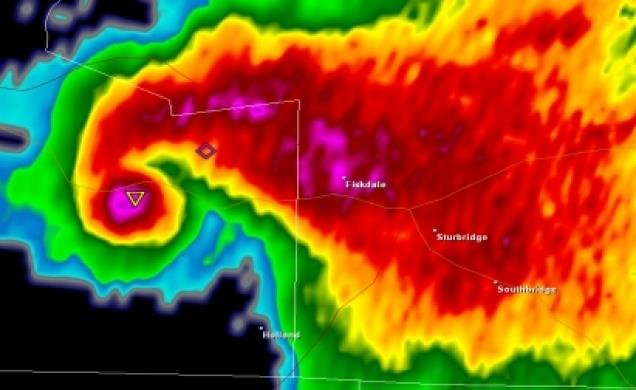-
Posts
77,947 -
Joined
-
Last visited
Content Type
Profiles
Blogs
Forums
American Weather
Media Demo
Store
Gallery
Everything posted by weatherwiz
-

Feb 28th-March 1st long duration Miller B threat
weatherwiz replied to George001's topic in New England
Initial band looking quite healthy with some hefty 700 fronto. Expecting it to be ripping here any moment -

Feb 28th-March 1st long duration Miller B threat
weatherwiz replied to George001's topic in New England
yeah wild looking cells, one with the TDS. Really intrigued to see how this convection impacts things downstream. It does have me nervous -

Feb 28th-March 1st long duration Miller B threat
weatherwiz replied to George001's topic in New England
18z NAM around BDL (or some place in Hartford County). Even a bit of a MAUL. Could certainly help with intense rates for a bit of a time -

Feb 28th-March 1st long duration Miller B threat
weatherwiz replied to George001's topic in New England
Well I guess now is a good time to start watching radar trends across OH and PA...which is actually fun because there is some severe weather involved. TDS near Carlisle, OH. Hopefully the radar blossoms beautifully in the upcoming hours -

Feb 28th-March 1st long duration Miller B threat
weatherwiz replied to George001's topic in New England
12z GFS bufkit for BDL. This is pretty damn solid. Pretty impressive ratios too with that heavier lift EDIT: Ratios as high as 13:1 to 15:1 with that -
Hello summer
-

Feb 28th-March 1st long duration Miller B threat
weatherwiz replied to George001's topic in New England
Most probably melts before then anyways -

Feb 28th-March 1st long duration Miller B threat
weatherwiz replied to George001's topic in New England
Yup...problem too is you really can't incorporate those type of processes into a forecast map. I guess the best thing you can do is hedge more towards the conservative side and then stress there is potential for some localized higher amounts. -

Feb 28th-March 1st long duration Miller B threat
weatherwiz replied to George001's topic in New England
Yup...that has been the consensus pattern we've been in which has continued to favor de-amplifying systems and cutter types with weakening QPF just due to decaying dynamics. It is a pleasure to see QPF increasing this close out and this is a big thanks to some increasing dynamics as the storm sort of re-evolves (so to speak). I am still a bit nervous about this though, especially with the signals of this being more convective in nature (as clarification speaking regarding Connecticut, obviously there are processes which occur further east which compensate). -

Feb 28th-March 1st long duration Miller B threat
weatherwiz replied to George001's topic in New England
This is why those things are just ridiculous. I'll admit, they have value in the short-term (as in <24-hours) and can be useful with picking up local maxima's/minima's and gradients, but anything beyond this term...it's just ridiculous, especially in medium-range. All they do is elicit merely unrealistic expectations and the hype train leaves the station and then eventually derails when reality sets in. -

Feb 28th-March 1st long duration Miller B threat
weatherwiz replied to George001's topic in New England
6z right around BDL...pretty solid. Start to get dry air seeping into the DGZ by 9z though. But it's pretty juicy -

Feb 28th-March 1st long duration Miller B threat
weatherwiz replied to George001's topic in New England
It was fun when I went to school at WestConn and being on the Westside Campus during mix events. At the top of the hill where housing was we would be getting snow (and accumulating snow) and you could walk down the hill and just see the transition happen in front of your eyes. There was one event it was almost like the line was drawn out between accumulation and non-accumulation. -

Feb 28th-March 1st long duration Miller B threat
weatherwiz replied to George001's topic in New England
There may still be some high clouds leftover across eastern sections -

Feb 28th-March 1st long duration Miller B threat
weatherwiz replied to George001's topic in New England
Looking outside the snow maps there have been some inconsistencies and certainly some flags. Why I remained with 3-6'' statewide instead of going anything higher. Where the best llvl fronto band and heaviest rates occur there may be some 6-7'' totals. But this all seems rather fast to me for those higher amounts to be widespread. You can see on the sim reflectivity's on many guidance that after the initial push of lift big issues start to occur. Even if we see lighter snows well into Tuesday morning or early afternoon I don't see it really accumulating to much (have to go northeast into Mass for that). -

Feb 28th-March 1st long duration Miller B threat
weatherwiz replied to George001's topic in New England
This is what really worries me. I'm envisioning a precip shield which is predominately light snow with poor ratios and snow growth with only embedded areas of enhanced lift where you'll have better rates/ratios. These systems with these convective looks have a way of screwing things up. -

Feb 28th-March 1st long duration Miller B threat
weatherwiz replied to George001's topic in New England
Who the hell knows where the max strip is going to be. Models have not been very consistent with some of these features. -

Feb 28th-March 1st long duration Miller B threat
weatherwiz replied to George001's topic in New England
I'm still thinking a general 3-6'' for Connecticut with maybe a few 7'' totals, but I think there are a little too many uncertainties to think that is likely. Seems like the window for the best lift and snow growth is rather small and even under that best lift snow rate are 1'' (maybe slightly more per hour). I'm also wondering if the convection crossing the Ohio Valley will factor into anything at all. Was wondering if it could actually help us in a sense. -

Feb 28th-March 1st long duration Miller B threat
weatherwiz replied to George001's topic in New England
6z NAM bufkit for BDL shows a pretty nice crosshair signature with a few hours of some impressive rates. Problem is for some higher totals (getting into 6-8'' range) is this period of lift is very brief. You can also see how quickly we start drying out -

Feb 28th-March 1st long duration Miller B threat
weatherwiz replied to George001's topic in New England
even seems kind of convective like -

Feb 28th-March 1st long duration Miller B threat
weatherwiz replied to George001's topic in New England
500. This was a huge issue raised last week but here is the 0z NAM 500mb winds looking at hour 3. See how the jet streak is already rounding the base of the shortwave trough? That is an indication the system overall is at peak maturity and will begin to de-amplify. The fast flow doesn't offer much room or support for additional amplification either. The whole system just craps out quickly. I'm just going to stick 3-6'' statewide. -

Feb 28th-March 1st long duration Miller B threat
weatherwiz replied to George001's topic in New England
ahh gotcha. If I'm understanding correctly would be 500mb. You can see the main shortwave as it ejects through the Missouri Valley into the Ohio Valley it just gets shredded apart. The spawning secondary low helps to blossom some precipitation but the shield just gets eroded away quickly. Overall, the degree of lift actually looks pretty meh outside of the initial WAA push. Even seems to be quite a bit of subsidence...almost like shortwave subsidence in a way with the initial shortwave energy passing east and approaching shortwave from the west (which even seems to help generate light stuff through the morning). -

Feb 28th-March 1st long duration Miller B threat
weatherwiz replied to George001's topic in New England
ratios? -

Feb 28th-March 1st long duration Miller B threat
weatherwiz replied to George001's topic in New England
Very true. -

Feb 28th-March 1st long duration Miller B threat
weatherwiz replied to George001's topic in New England
IDK...even looking back at the 18z NAMs I think the idea makes sense. The secondary is awfully far south and I guess it's a question of how far north the strongest fronto can get. also, it seems like the northern edge of the precip shield gets chewed away pretty quickly. Ton of dry air up at 500 and have to wonder if that is quickly seeping downward. I'm thinking like 5-8'' for SW CT and along the shoreline to about the River with 3-5'' from northern Litchfield county elsewhere. I'll post map in a bit to illustrate. -

Feb 28th-March 1st long duration Miller B threat
weatherwiz replied to George001's topic in New England
I'm starting to think the jackpot zone in this will be across southern Connecticut. It kind of makes sense based on where guidance is developing/tracking the secondary low. You can see the precip shield starting to fall apart pretty quickly towards eastern CT. Best lift traverses southwest/coastal Connecticut and thermal profile supports all snow.





